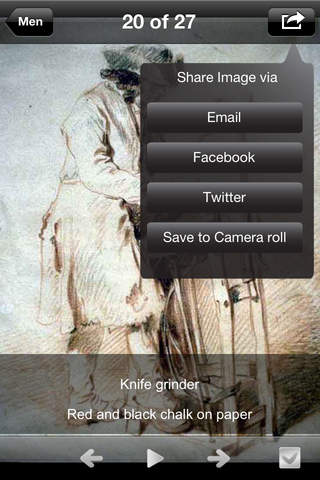
Drawings: Antoine Watteau
In this FULL VERSION, you will find over 100 drawings by the great Antoine Watteau. Enjoy the high quality images of his drawings, share them with your friends via email, and learn about the artist life.
Jean-Antoine Watteau (1684–1721) was a French painter whose brief career spurred the revival of interest in color and movement (in the tradition of Correggio and Rubens), and revitalized the waning Baroque idiom, which eventually became known as Rococo. He is credited with inventing the genre of fêtes galantes: scenes of bucolic and idyllic charm, suffused with an air of theatricality. Some of his best known subjects were drawn from the world of Italian comedy and ballet. Watteau anticipates the world of art as seen through the eyes of an artist. His mature paintings display a sober melancholy, a sense of the ultimate futility of life, that makes him, among 18th century painters, one of the closest to modern sensibilities. Watteaus influence on the arts (not only painting, but the decorative arts, costume, film, poetry, music) was more extensive than that of almost any other 18th-century artist. In his treatment of the landscape background and of the atmospheric surroundings of the figures can be found the germs of Impressionism.
Admiration for the drawings of Watteau has always been equal to that of his paintings. He drew few compositional studies; for the most part, his graphic oeuvre is made up of chalk studies of heads or figures. He filled sketchbooks with incisive renderings of figures drawn from life, which he would later mine for his painted compositions. Although he limited himself to chalk, there is a clear evolution in the technique of Watteaus drawings, as he added different colors to the mix. Although Watteau did not invent the technique of trois crayons, his name is always linked to the technique for his intuitive mastery of it, melding red, black, and white to great painterly and coloristic effect.



